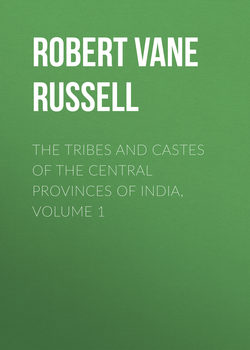Читать книгу The Tribes and Castes of the Central Provinces of India, Volume 1 - Robert Vane Russell - Страница 22
Part I.
Introductory Essay on Caste
Introductory Essay on Caste
19. Castes ranking above the cultivators
ОглавлениеThe castes of the first group are noted below:
The Brāhmans are, as they have always been, the highest caste. The Rājpūts are the representatives of the ancient Kshatriyas or second caste, though the existing Rājpūt clans are probably derived from the Hun, Gūjar and other invaders of the period before and shortly after the commencement of the Christian era, and in some cases from the indigenous or non-Aryan tribes. It does not seem possible to assert in the case of a single one of the present Rājpūt clans that any substantial evidence is forthcoming in favour of their descent from the Aryan Kshatriyas, and as regards most of the clans there are strong arguments against such a hypothesis. Nevertheless the Rājpūts have succeeded to the status of the Kshatriyas, and an alternative name for them, Chhatri, is a corruption of the latter word. They are commonly identified with the second of the four classical castes, but a Hindu law-book gives Rājapūtra as the offspring of a Kshatriya father and a mother of the Karan or writer caste.45 This genealogy is absurd, but may imply the opinion that the Rājpūts were not the same as the Aryan Kshatriyas. The Khatris are an important mercantile caste of the Punjab, who in the opinion of most authorities are derived from the Rājpūts. The name is probably a corruption of Kshatri or Kshatriya. The Banias are the great mercantile, banking and shopkeeping caste among the Hindus and a large proportion of the trade in grain and ghī (preserved butter) is in their hands, while they are also the chief moneylenders. Most of the important Bania subcastes belonged originally to Rājputāna and Central India, which are also the homes of the Rājpūts, and reasons have been given in the article on Bania for holding that they are derived from the Rājpūts. They, however, are now commonly called Vaishyas by the Hindus, as, I think, under the mistaken impression that they are descended from the original Vaishyas. The Bhāts are the bards, heralds and genealogists of India and include groups of very varying status. The Bhāts who act as genealogists of the cultivating and other castes and accept cooked food from their clients may perhaps be held to rank with or even below them. But the high-class Bhāts are undoubtedly derived from Brāhmans and Rājpūts, and rank just below those castes. The bard or herald had a sacred character, and his person was inviolable like that of the herald elsewhere, and this has given a special status to the whole caste.46 The Kāyasths are the writer caste of Hindustān, and the Karans and Prabhus are the corresponding castes of Orissa and Bombay. The position of the Kāyasths has greatly risen during the last century on account of their own ability and industry and the advantages they have obtained through their high level of education. The original Kāyasths may have been village accountants and hence have occupied a lower position, perhaps below the cultivators. They are an instance of a caste whose social position has greatly improved on account of the wealth and importance of its members. At present the Kāyasths may be said to rank next to Brāhmans and Rājpūts. The origin of the Prabhus and Karans is uncertain, but their recent social history appears to resemble that of the Kāyasths. The Guraos are another caste whose position has greatly improved. They were priests of the village temples of Siva, and accepted the offerings of food which Brāhmans could not take. But they also supplied leaf-plates for festivals, and were village musicians and trumpeters in the Marātha armies, and hence probably ranked below the cultivators and were supported by contributions of grain from them. Their social position has been raised by their sacred character as priests of the god Siva and they are now sometimes called Shaiva Brāhmans. But a distinct recollection of their former status exists.
Thus all the castes of the first group are derived from the representatives of the Brāhmans and Kshatriyas, the two highest of the four classical castes, except the Guraos, who have risen in status owing to special circumstances. The origin of the Kāyasths is discussed in the article on that caste. Members of the above castes usually wear the sacred thread which is the mark of the Dwija or twice-born, the old Brāhmans, Kshatriyas and Vaishyas. The thread is not worn generally by the castes of the second group, but the more wealthy and prominent sections of them frequently assume it.
45
Wilson, Indian Caste, i. 440, quoting Brahma Vaivarrta Purāna.
46
See article Bhāt for further discussion of this point.
